Viscum Biology
Click on Figs. with red numbers for enlargement. Click on the black background to return to the page.
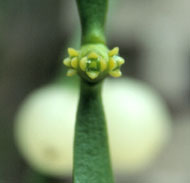
Fig. 1. Viscum album spp. album, female inflorescence.
Fig. 4. Distribution of the genus Viscum. In the North and West most species are dioecious. Towards South and East most species are monoecious. (Redrawn from B. A. Barlow 1983).

Fig. 6. Viscum album ssp. austriacum. Male flowers visited by a fly. The multi-chambered pollen sacs are united with the perianth and pollen sprinkle from a hole per chamber.
Fig. 9. Eating-place in Baja California for Phainopepla nitens, a silky-flycatcher. Large clumps of red seeds of Phoradendron californicum stick to the twigs of a Bursera sp. – A large haustorium of a leafless and possibly dead parasite, Psittacanthus sonorae, is visible.
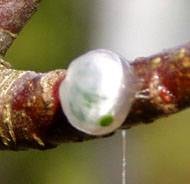
Fig. 10. Viscum album. Green chlorophyllous seed leaves are shining through the innermost thin layer of the fruit wall. The basal end of the hypocotyl is just about to emerge.
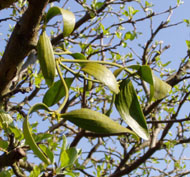
Fig.12. Viscum album. One pair of opposite leaves develop from each node per year.
Fig. 13. An American mistletoe, Phoradendron villosum, growing on a row of oak trees (Quercus kellogii) between two fields SE of San Diego.
Fig. 15. Unripe green fruits of Viscum minimum on Euphorbia horrida, South Africa. Photo: Brian Fineran.
Fig. 17. Diagram showing endophyte and haustorial system in Viscum. See enlargement for details.
Fig. 19. Nothanthera heterophylla (Loranthaceae). Epicortical roots with secondary haustoria (arrow) and vegetative shoots. Photo: Job Kuijt.
Viscum is the scientific generic name for mistletoe, which belongs to the family Viscaceae in the sandalwood order (Santalales). In Europe the name mistletoe normally refers to the species Viscum album (European mistletoe) and other closely related species in the same genus. However, in most English speaking countries mistletoe also includes the remainder six genera in the family as well as a great number of genera in Loranthaceae, a family only represented by Loranthus europaeus in Europe. None the less, distinct differences in the flowers and inflores-cences occur between the two families. The inflorescence of Viscum is often described as a three-flowered cyme (Fig. 1) but may also be interpreted as a spike having extremely short internodes and a terminal flower. In this case, the inflorescence of Viscum becomes the natural starting point for the development of spikes in the other genera of Viscaceae. The flowers are small, i.e. up to two mm in diameter and the berry has only one seed. In Loranthaceae the flowers are at least 5 mm long and often much longer (Fig. 2) and the berry has two to several seeds.
Mistletoes are parasitic plants, i.e. they depend on having water and some nutrients supplied from another plant called the host. There are two main groups of parasitic plants. Hemi-parasites are green plants with chlorophyll and photosynthesis. They can produce all or the main part of all necessary carbon compounds if they have access to water, light, and carbon dioxide. Viscum belongs to this group. The other group, the holoparasites, needs to have all water and all nutrients supplied by the host. In each group there are parasites growing on either the roots or the stems of the host and they are called root parasites and stem parasites respectively. Mistletoes are hemiparasitic stem parasites.
For centuries much mysticism and many misinterpretations have occurred concerning the biology of mistletoes. Although birds were seen eating the berries, botanists of the early 19th century were still unwilling to recognize that mistletoes can germinate from droppings of birds. The general belief was that mistletoes emerged on the trees more or less like warts appear in humans. Later on, the idea was that the seeds must pass the digestive duct of birds in order to germinate but this is only the case in a few species. The name mistletoe may have appeared through the relation between Viscum and bird droppings since in German ‘der Mist’ means dung.
In Nordic mythology, the mistletoe is known from the myth of the death of Balder. The great good Odin’s handsome and good son Balder was invulnerable to weapons since his mother Frigg had sworn in all plants, metals, and everything else which could be used for weapons. However, she overlooked the mistletoe, since it did not grow on the surface of the soil. According to the myth the evil god Loke prepared an arrow from the mistletoe (Viscum album, Fig. 3), and during weapon games Loke persuaded Øder (Oeder), the blind brother of Balder, to shoot the arrow through Balder and hence he was killed. Balder had a chance to return from the land of the dead but the disguised Loke would not as requested shed a tear and therefore the fate of Balder was definitive. This myth is the foundation for the Danish saying: remember to put the mistletoe on oath.
In other prehistoric cultures too, the European mistletoe has been ascribed supernatural powers. From the time of the druids to way up in the last century this mistletoe has played an important role in religious ceremonies. The druids were Celtic priests with great religious power. Dressed in white robes they performed offerings of both animals and humans on a fire, and mistletoes harvested by golden sickles formed part of the ceremony. Most likely, a connection exists from these events to f.ex. the Swedish mid-summer feast. On this occasion fires are light, and until the plant was preserved, mistletoes (Viscum album) were collected. In folk medicine mistletoe has been used to cure almost any kind of illness. In part of Austria it was even believed the berries could prevent pregnancy. It is likely that immigrants from Europe transferred this dubious effect to Phoradendron in western North-America. The most reliable effect of medicaments containing lectin prepared from Viscum album seems to be a relieving but not curing effect on certain kinds of cancer and inflammatory joint diseases.
There are seven genera in the mistletoe family Viscaceae and more than 500 species. Their main distribution is in tropical and subtropical climates, although, the family has few representatives in Australia (Fig. 4). Viscum album extends farthest north in Europe. Its northern limit crosses Denmark where it is doubtful if there are any natural populations left but it is grown in many gardens. In Norway a very healthy population occurs on islands in the relatively mild Oslo Firth. In relation to the expected warmer winter climate due to global warming, Viscum album may spread further north in the coming years. The most species rich genera of the family are the North-American Phoradendron with 234 species and Viscum with 130 species. They are all evergreen stem parasites. In several species the leaves are so reduced that almost all photosynthesis occurs in the stems. Some have even become stem succulents, i.e. they have thick stems for water storage (Fig. 5).
The flowers of Viscum are unisexual and the ovary is inferior. The two sexes can occur on the same (monoecious) or on different plants (dioecious, Fig. 1 and 6). Nectar is often present at the bottom of female flowers but the fluid in the flower (Fig. 1) may primarily serve to catch pollen. As the fluid dries, pollen transferred by insects or wind will land on the stigma. During the early flowering in April the flowers are visited by several insect species (Fig. 6). The fruit is a berry with one seed only. The fruit wall consists of three layers (Fig. 7). The outermost layer is thin, leathery, and red, yellow, orange, or white to attract birds. The middle layer is thick and fleshy containing a sticky substance, viscin, produced as the cells turn into mucilage. Viscin from the American mistletoe Phoradendron californicum primarily consists of highly ramified xylans. In most mistletoe species there are two kinds of cells in the viscin layer. The rounded cells in the outer part are responsible for the sticky quality while the lengthy, spirally inner cells are responsible for the elastic property of the viscin (Fig. 7). The third and innermost layer of the fruit wall is as thin as the outermost layer and it adheres strongly to the seed (a true seed coat or testa does not occur). Hence, the viscin makes it possible for the seed to adhere to the surface of a host. The seeds often contain more than one embryo which all may germinate (Fig. 8).
The fruits are dispersed by birds. The outermost coloured and relatively hard shell is removed by the birds before the rest of the fruit is swallowed. In this manner some seeds are dispersed by the droppings of birds. Others stick to twigs while the bird is trying to get rid of the outermost part of the fruit shell. Due to the behavior of the birds which may have regular eating places the seeds are often dispersed in clumps (Fig. 9). This implies a risk for greater mortality among the seedlings due to mutual competition when the seeds are germinating almost side by side. However, as an advantage, dispersal in clumps also secures that both sexes are within close distance of one another. The fruits are generally dispersed by closely related bird species such as the Dicaeidae in Southeast Asia and Euphonia in America. In Europe it is mainly the mistletoe thrush (Turdus viscivorus) which disperses the seeds of Viscum album. In South European and North African countries viscin from a number of species has until far into the 20th century been used as birdlime to catch birds. The sticky viscin was smeared on twigs and when small songbirds tried to rest on the twigs they were caught easily.
Both the cotyledons (seed-leaves) and the endosperm contain chlorophyll, hence the seed appears more or less green (Fig. 10). Germination is a slow affair. In this situation it is an advantage to be able to perform photosynthesis as soon as germination begins. The parasite must be self supplying until a functional haustorium has been established. A haustorium is a physical connection to the conducting tissues of the host through which water and nutrients can be transported from the host to the parasite. Normally, there are two cotyledons. In Viscum they are united almost to the base leaving only a small fissure through which the first pair of leaves emerges. At that time all stored nutrients have been used, the cotyledons are wilted, and they only leave a white scar each (Fig. 11 + more Figures of germinating Viscum album on the page Growing Mistletoe) The berries ripen during winter a couple of months before flowering in April (in Denmark) and new flowers are often seen along with the fruits from flowers of the previous year (Fig. 1). The germination ability only last for a few weeks after the berry is removed from the mother plant. However, it takes as long as one to four years from germination to the first pair of leaves emerges assuming the haustorium was successfully establish during the first growing season. Growth continues to be slow, and Viscum produces only one stem internode with one pair of opposite leaves per growing season (Fig. 12). Next year new shoots develop from the axils of each leaf. This growth pattern (Fig. 3) produces with age an almost spherical or an ellipsoid hanging plant.
There are great differences in the host specificity of different parasitic plants, i.e. how particular parasites are about their hosts. Viscum album belongs to the lesser host specific and a number of hard wood species are accepted as hosts. Even among parasites belonging to the same genus there is often great variation in their host specificity. However, there is also often great uncertainty about the observed host specificity. The uncertainty has several reasons but in particular there are problems interpreting the negative observations. If a certain parasite does not grow on a certain host species, the reason may be other than tissue incompatibility. The situation may be explained by differences in the ecology of the two species. Insufficient light conditions or the way dispersal occurs could be the explanation. This becomes clear looking at bird dispersal of mistletoe seeds. It is very normal for several mistletoe species to see them occur in great numbers on solitary trees, or in rows of trees along field boundaries (Fig. 13), or at the edge of a forest while the same host species and other potential host species growing in the forests are not attacked by the parasites. The reason is that the birds dispersing the seeds only live in open land. Concerning the green hemiparasites, they generally are so light demanding that they rarely occur in the woods despite the existence of many potential hosts in the wood.
In general, the problems mentioned above cause the number of acceptable hosts to be underestimated. This is clearly illustrated by growth experiments in the Botanic Garden in Copenhagen using the dwarfish mistletoe Viscum minimum (Fig. 14). The natural occurrence of this species is in the Cape Province of South Africa. Here it is only parasitic on two succulent species of Euphorbia (spurge), E. polygona and E. horrida (Fig. 15). In the experiment, a representative number of species from five different genera in the spurge family (Euphorbiaceae), a succulent Plumeria (Apocynaceae), and a succulent cactus (Peniocereus) were used as potential hosts. Viscum minimum could be established on 28 of the 63 tested species from the Euphorbiaceae but not on species from other genera of the family. In all cases the accepted hosts were succulent and closely related (belonging to three of 19 groups in the family). Further, they all have their main distribution on the main land south of Sahara with one exception on Madagascar and one in Morocco. The conclusion is that under natural conditions host specificity is determined by geographical (distribution) and ecological factors, and in particular by dispersal ecology.
Below is given some examples of host specificity in Viscum (note the variation):
Viscum album ssp. album – accepts more than 100 genera and 230 species of dicotyledoneous trees.
V. album ssp. abietis – several species of Silver-fir, Abies spp.
V. album ssp. austriacum – Pine (Pinus spp.) and Larch (Larix spp.). – Fig. 16.
V. album ssp. cretica – so far only on Pinus halepensis subsp. brutia.
V. cruciatum in Europa – mainly Olive, Olea europaea.
V. minimum in nature – two Spurges, Euphorbia horrida and E. polygona.
V. minimum in culture – at least 28 species of Euphorbia.
Viscum develops only one haustorium called a primary haustorium because it is initiated directly from the basal end of the hypocotyl (the stem bearing the seed leaves). Viscum has no primary root. The haustorium consists of an adhesive disk (Figs. 11 and 17-18) and an intrusive organ (Fig. 17). At the interface the outermost cell layer (epidermis) of the adhesive disk consists of glandular cells which secrete a sticky lipidic substance (Fig. 18). This substance glues the two parts together during germination. From cells inside the adhesive disk a new growth point develops and this growth point produces the intrusive organ. By a combination of enzymatic decomposition and mechanical forces the intrusive organ first penetrates the outermost cell layers of the adhesive disk and then the epidermis and primary bark (cortex) of the host. It continues growth until contact is obtained to the water conducting system (xylem) of the host. The hydrostatic pressure in the cells of the two parts is in favor of the parasite and hence water with dissolved nutrients will always flow from the host to the parasite and not in the opposite direction. Even after contact has been obtained to the conducting tissue, the intrusive organ continues to grow and ramify in the cortex of the host (Figs. 17). The ramifications running parallel with the axis of the host twig are called cortical strings. From these cortical strings new so called secondary sinkers make more contacts to the conducting tissue of the host. Some species also develop flowering shoots from the strings (Figs. 17 and 20). The complete system of parasite cells inside the host is called the endophyte, while the green parts and flowers outside the host are named the exophyte.
Members of the mistletoe family (Viscaceae) are considered the most advanced parasites in the sandalwood order (Santalales). Most members of the Loranthaceae also develop a primary haustorium directly from the radicle but in addition they also produce adventitious roots from the hypocotyl (the stem below the seed leaves). These roots grow along the twig or stem of the host and are named epicortical roots (Fig. 19). Along these roots secondary haustoria develop and they also make contact to the conducting tissue of the host. In Viscum the cortical strings are interpreted as epicortical roots which have moved from the surface of the host into the cortex of the host and the secondary haustoria have become secondary sinkers. Three years of growth of the cortical strings in Viscum minimum can be followed in Fig. 20.
The transfer of nutrients from the host to the parasites weakens the host to some degree. Normally, a parasite attack will not cause the death of the host, since the parasite at the same time will loose its foundation for existence. Generally, an attack of Viscum will result in reduced growth and fewer flowers and fruits on the twigs carrying the mistletoe. However, in southern Europe more serious attacks occur resulting in reduced fruit harvest and destroyed timber. The only available method for combating mistletoes is to cut away the attacked twigs containing the endophyte since mistletoes can develop new shoots from the cortical strings. In the most highly developed species such as Viscum minimum even all flowering shoots originate from the cortical strings (Fig. 17).
For more information and references see D. L. Nickrent: The Parasitic Plant Connection
or search the WEB for Viscum and Viscaceae using search engines such as Google.
Link to growing Viscum album in your garden.
Illustrated articles in Danish on the biology of parasitic plants including other mistletoes such as Phoradendron and the harmful Arceuthobium are included in the Publication List (No.53-56).
———————-H. S. Heide-Jørgensen, July 4, 2004
Seven genera in Viscaceae:
Dendrophthora,
Phoradendron,
Ginalloa,
Korthalsella,
Notothixos,
Viscum.
Arceuthobium.
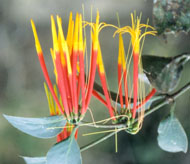
Fig. 2. Aethanthus nodosus from Eucuador, a typical Loranthacean flower pollinated by birds. Photo: Job Kuijt.

Fig. 3. Viscum album. Very short internodes make up the non-straight stems. Hence, the stems are not suitable for manufacturing arrows much longer than 10 cm. To give the myth about Balder some reality, one may imagine that only the arrowhead was made of the mistletoe.
Fig. 5. Viscum capense from South Africa is a stem succulent with leaves reduced to scales. Photo: J. Damgaard Petersen.
Fig. 7. Viscum album. Seed adhering to an apple twig. The thin outermost layer of the fruit wall is hanging in a string of elastic viscin from the middle layer of the fruit wall. The dark embryo is shining through the thin innermost layer of the fruit wall. Four scars of tepals and the pistil are seen on the outermost layer.

Fig. 8. Viscum album. Seed with two germinated embryos.

Fig. 11. Viscum album. An adhesive disk (left) has developed from the basal end of the hypocotyl, while the first pair of leaves is developing from the opposite end. Between the leaves, a white scar from a seed leaf is seen.
Fig. 14. Viscum minimum. Red fruits on female plant grown on Euphorbia fimbriata. Red arrow: 2 mm high fully mature vegetative shoot.
Fig. 16. Viscum album ssp. austriacum on Pinus sylvestris.

Fig. 18. Diagram showing the development of the adhesive disk from the basal end of the hypocotyl in Viscum. cz, zones of collapsed cells give room for the growth point (m) which develop the intrusive organ. v, host. Gray, sticky lipids secreted from glandular epidermal cells.
Fig. 20. One individual of Viscum minimum grown on the stem of Euphorbia monteiroi. The adhesive disk of the primary haustorium is seen at the yellow arrow. The yellow dots marks the approximate position of the cortical strings inside the stem of the host.
Examples on African Viscum species - added Nov. 2020
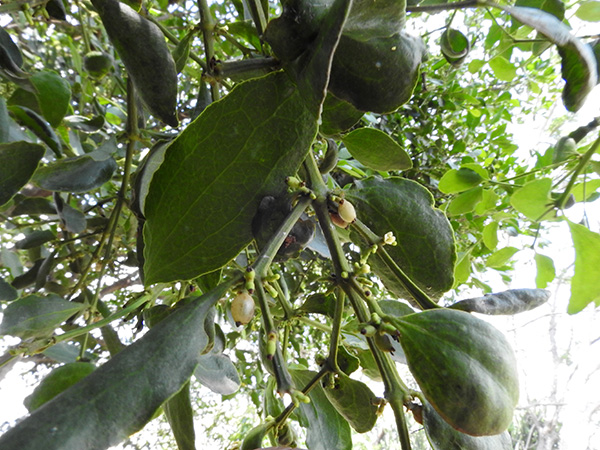
Viscum triflorum is found in a band from the eastern coast of South Africa through the Rift Valley to the Red Sea. It is also present on the Comores, the Mascarenes, and the Seychelles. The berries are white.
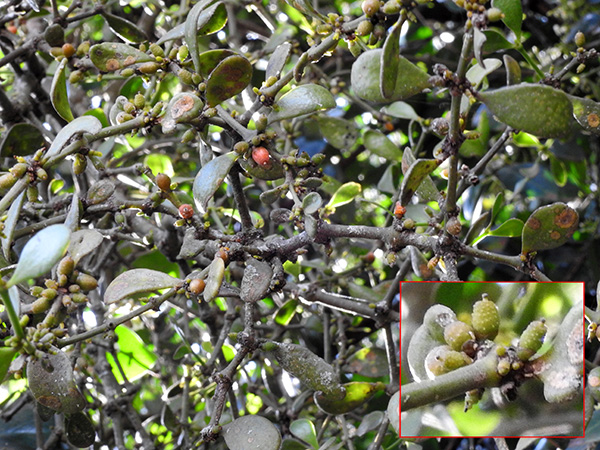
Viscum tuberculatum has e similar distribution as V. triflorum except it is not present on the islands of the Indian Ocean. The name tuberculatum alludes to the smal warts present onm immmature green fruits. (see inserted photo).
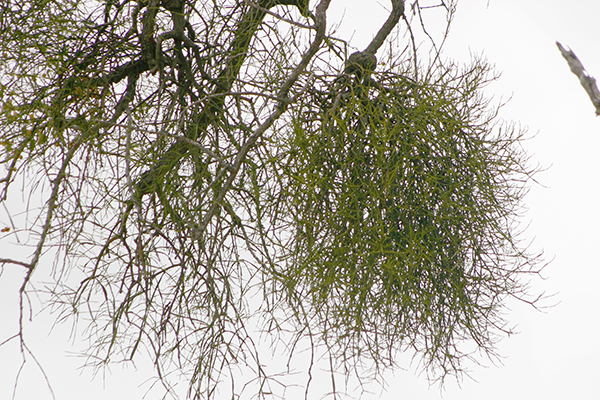

Viscum combreticola is found in Africa south of Sudan. It is a stem assimilant withouth leaves. The stems are flat and turned 90° from node to node. Notice the clearly visible haustorium on the left photo. Mature berries are red.
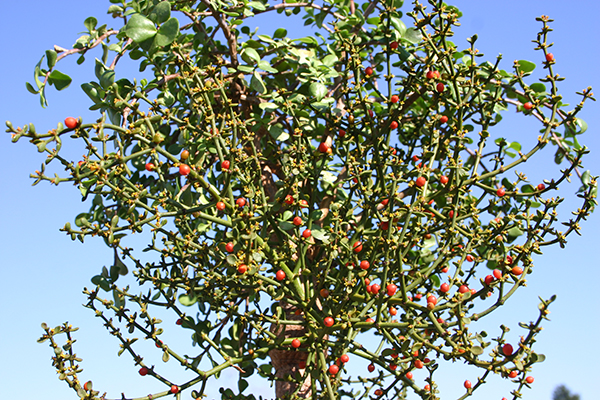

Viscum crassulae is present in the very southernmost South-Africa. It mainly parasitises Portulacaria afra but is also found on succulent (Euphorbia). It flowers Juli-August and at the same time ripe red berries from the preceeding year are present.

Viscum minimum is the smallest species of the genus with only four mm long vegetative shoots. It is known from a very small coastal area of the southernmost South Africa. As mentioned above, in nature it is only known from two succulent species, Euphorbia horrida and E. polygona, but since the plant is so small and difficult to see it may have a larger distribution, although not larger than the distribution of the host species.

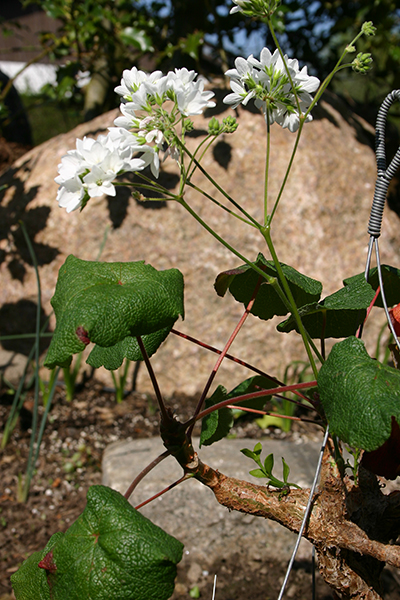

Viscum rotundifolium occurs in southernmost Africa. The berries are orange. The parasite is an example of a Viscum species with low host specificity since it may accept species from 15 different genera as host (inclusive Tapinanthus and Viscum from Viscaceae) representing 13 families. It also accepts hosts not present within the natural distribution of the parasite. – The pictures show V. rotundifolium on three succulent hosts. From left, Euphorbia horrida as a natural host. In the middle, a young plant on Pelargonium cotyledonis from Sct. Helena Island, and to the right an American cactus species Cleistocactus samaipatamu. – Note that the stems of the hosts swells considerably around the haustorium, and in Cleistocactus, the hormone system is disturbed so much that the host produces adventitious roots.
Supplementary literature:
Calder M & P. Bernhardt, 1983: The biology of Mistletoes. Academic Press Australia, Sydney.
Heide-Jørgensen, H S. 1989. Development and ultrastructure of the haustorium of Viscum minimum Harvey. I. The adhesive disk. – Can. J. Bot. 67: 1161-1173.
Kuijt, J. 1969: The biology of parasitic flowering plants. – University of California Press. Berkeley.
Polhill, R. & Wiens, D. 1998. Mistletoes of Africa. The Royal Botanic Gardens, Kew.
Press, M.C & Graves J.D. (eds.). 1995: Parasitic Plants. Chapman & Hall, London.
Tubeuf, C. von. 1923: Monographie der Mistel. Berlin, Oldenbourg.
H. S. Heide-Jørgensen, november 2020.

